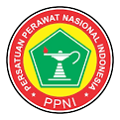Teknologi Elektroflokulasi Bertingkat Kombinasi Media Pasir - Arang Aktif sebagai Pengolahan Limbah Cair Industri Tapioka
DOI:
https://doi.org/10.26630/jk.v13i1.2835Keywords:
Activated charcoal, Level lectrofloculation, Tapioca liquid waste.Abstract
Tapioca industrial waste is still a problem and needs to be treated before being discharged into water bodies. The waste generated can be in the form of solid waste, gas waste, and liquid waste. This research is an experimental study and uses tapioca industrial wastewater samples which previously measured the parameters of TSS, BOD, COD, PH, and odor. Then processing is carried out by flowing continuously into the processor with multilevel electro flocculation technology, a combination of activated charcoal sand media with 12-volt electric current using control without activated charcoal sand media. The purpose of the study was to determine the electro flocculation ability of the combination of sand-activated charcoal media (thickness variations of 20cm, 40cm, 60cm, 80cm) in processing tapioca waste. The results showed a decrease in the levels of TSS, BOD, COD, pH, and odor. The most effective reduction was in the variation of activated charcoal sand media with a thickness of 60 cm. The results of the statistical test showed differences in the level of reduction in the pollutant content of tapioca waste TSS, BOD, COD, pH, and odor in the multistage electro flocculation process in the combination of sand–activated charcoal media with a p-value=0.00. The results of the study can be used as an alternative in the processing of tapioca industrial wastewater.References
Al Fatoni, Devi, and Hari Rudijanto Indro Wardono. (2019). Studi Pengolahan Air Limbah Tapioka Di Pabrik Aci. Buletin Keslingmas 38(3). https://doi.org/10.31983/keslingmas.v38i3.5396
Andrade, Aline Nunes, et al. (2020). Efficiency of Electroflocculation in the Treatment of Water Contaminated by Organic Waste. Revista Ambiente e Agua 15(2). https://doi.org/10.4136/ambi-agua.2484
Azizah, Rifka Noor, Agus Slamet, and Adhi Yuniarto. (2017). Evaluasi Instalasi Pengolahan Air Limbah Industri Tapioka Di Kabupaten Lampung Timur. IPTEK Journal of Proceedings Series 3(5). http://dx.doi.org/10.12962/j23546026.y2017i5.3126
Bleeke, Franziska, Gunnar Quante, Dominik Winckelmann, and Gerd Klöck. (2015). Effect of Voltage and Electrode Material on Electroflocculation of Scenedesmus Acuminatus. Bioresources and Bioprocessing 2(1). https://doi.org/10.1186/s40643-015-0064-6
Chatsungnoen, Tawan, and Yusuf Chisti. (2019). Flocculation and Electroflocculation for Algal Biomass Recovery. Biofuels from Algae. Elsevier. https://doi.org/10.1016/B978-0-444-64192-2.00011-1
Darmansyah, Darmansyah, Simparmin Ginting, Lisa Ardiana, and Hens Saputra. (2016). Mesopori MCM-41 Sebagai Adsorben: Kajian Kinetika Dan Isotherm Adsorpsi Limbah Cair Tapioka. Jurnal Rekayasa Kimia & Lingkungan. 11(1) https://doi.org/10.23955/rkl.v11i1.4228
Fayad, Nidal, Tania Yehya, Fabrice Audonnet, and Christophe Vial. (2017). Harvesting of Microalgae Chlorella Vulgaris Using Electro-Coagulation-Flocculation in the Batch Mode. Algal Research 25. https://doi.org/10.1016/j.algal.2017.03.015
Fuadi, Anwar. (2016). Pengarus Diameter Dan Ketebalan Pasir Pada Saringan Terhadap Total Solid Dalam Air. Jurnal Sains dan Teknologi Reaksi.
He, Huan, et al. (2021). The Treatment of Black-Odorous Water Using Tower Bipolar Electro-Flocculation Including the Removal of Phosphorus, Turbidity, Sulfion, and Oxygen Enrichment. Frontiers of Environmental Science and Engineering 15(2). https://doi.org/10.1007/s11783-020-1310-5
Huang, Xueqi, et al. (2019). Elimination of Electrode Passivation by Reversing Electrodes in the Process of Electroflocculation. Chinese Journal of Environmental Engineering 13(11). https://doi.org/10.12030/j.cjee.201901028
Ifadiana, Dewi Permata, and Juli Soemirat. (2016). An Analysis of the Effect of the Implementation of an Integrated Management System (IMS) on Work Ergonomics in an O&M Power Plant Company. Journal of Engineering and Technological Sciences. 48(2), 173-182.
Ikhlaq, Amir, et al. (2018). Combined Catalytic Ozonation and Electroflocculation Process for the Removal of Basic Yellow 28 in Wastewater. Desalination and Water Treatment 127. https://doi.org/10.5004/dwt.2018.22755
Ikhlaq, A., Javed, F., Akram, A., Rehman, A., Qi, F., Javed, M., ... & Aziz, H. A. (2020). Synergic catalytic ozonation and electroflocculation process for the treatment of veterinary pharmaceutical wastewater in a hybrid reactor. Journal of Water Process Engineering, 38, 101597. https://doi.org/10.1016/j.jwpe.2020.101597
Indrianeu, Tineu, and Elgar Balasa Singkawijaya. (2019). Pemanfaatan Limbah Industri Rumah Tangga Tepung Tapioka Untuk Mengurangi Dampak Lingkungan. Jurnal Geografi Geografi dan Pengajarannya 17(2). https://doi.org/10.26740/jggp.v17n2.p39-50
Irmanto, Irmanto, and Suyata Suyata. (2010). Optimasi Penurunan Nilai BOD, COD Dan TSS Limbah Cair Industri Tapioka Menggunakan Arang Aktif Dari Ampa Kopi. Molekul, 5(1), 22-32. http://dx.doi.org/10.20884/1.jm.2010.5.1.73
Koren, J. P.F., and U. Syversen. (1995). State-of-the-Art Electroflocculation. Filtration & Separation, 32(2), 153-146. https://doi.org/10.1016/S0015-1882(97)84039-6
Melchiors, Marina S. et al. (2016). Treatment of Wastewater from the Dairy Industry Using Electroflocculation and Solid Whey Recovery. Journal of Environmental Management 182. https://doi.org/10.1016/j.jenvman.2016.08.022
Mubarak, M., A. Shaija, and T. V. Suchithra. (2020). Evaluation of Ferric Chloride and Electroflocculation of Chlorella Pyrenoidosa and Reuse of the Culture Medium for Subsequent Cultures. Journal of Environmental Chemical Engineering 8(1). https://doi.org/10.1016/j.jece.2019.103612
Mulyani, Happy, Gregorius Prima Indra Budianto, Margono, and Mujtahid Kaavessina. (2018). The Influence of PH Adjustment on Kinetics Parameters in Tapioca Wastewater Treatment Using Aerobic Sequencing Batch Reactor System. AIP Conference Proceedings. https://doi.org/10.1063/1.5024066
Mulyono, Rifai Agung, and Wibowo Ady Sapta. (2020). Level of Electro Flocculation Technology as a Treatment of Household Industry Waste (Design and Building Design). International Journal of Innovation, Creativity and Change 13(2).
Ofir, E., Y. Oren, and A. Adin. (2007). Electroflocculation: The Effect of Zeta-Potential on Particle Size. Desalination, 204(1-3), 33-38. https://doi.org/10.1016/j.desal.2006.03.533
Palilingan, Septiany Christin, Meity Pungus, and Farly Tumimomor. (2019). Penggunaan Kombinasi Adsorben Sebagai Media Filtrasi Dalam Menurunkan Kadar Fosfat Dan Amonia Air Limbah Laundry. Fullerene Journal of Chemistry 4(2). https://doi.org/10.37033/fjc.v4i2.59
Rachmawati, Nurmeily. (2020). Pengaruh Adsorben Sebagai Media Filter Dalam Menurunkan Kadar Timbal Dalam Matrik Air Sungai. Walisongo Journal of Chemistry 3(2). https://doi.org/ 10.21580/wjc.v3i2.6448
Rahmawati, Rita, Eka Intan Kumala Putri, and Meti Ekayani. (2018). Internalisasi Limbah Cair Industri Kecil Menengah (IKM) Tapioka Melalui IPAL Biogas Untuk Pembangkit Listrik. Risalah Kebijakan Pertanian Dan Lingkungan: Rumusan Kajian Strategis Bidang Pertanian dan Lingkungan. 4(1). https://journal.ipb.ac.id/index.php/jkebijakan/article/view/20071
Ramos, Luciana C. et al. (2020). Evaluation of Electroflocculation Harvesting on the Antioxidant Activity and Toxicity of Extracts from the Microalgae Isochrysis Galbana and Phaeodactylum Tricornutum. Journal of Applied Phycology 32(6). https://doi.org/10.1007/s10811-020-02265-3
Rech, João Pedro Paim Bueno, and Alexandre Tadeu Paulino. (2019). Electroflocculation for the Treatment of Wastewater from Dairy Food Industry: Scale-up of a Laboratory Reactor to Full-Scale Plant. Clean Technologies and Environmental Policy 21(5). https://doi.org/10.1007/s10098-019-01682-4
Robinson, V. (1999). Electroflocculation in the treatment of polluted water. Australian Water and Wastewater Association. Joint NSW and Victoria State Conference, Wondonga (pp. 22-24).
Setyawaty, R., Setiadi, T., Katayama-Hirayama, K., Kaneko, H., Hirayama, K., Indonesia, J., & No, G. (2011). Polyhydroxyalkanoate (PHA) production from tapioca industrial wastewater treatment: Operating conditions and influence on PHA content. Environ Res, 22, 123-7.
Setyobudiarso, Hery, and Endro Yuwono. (2014). Rancang Bangun Alat Penjernih Air Limbah Cair Laundry Dengan Menggunakan Media Penyaring Kombinasi Pasir - Arang Aktif. Jurnal Neutrino. https://doi.org/10.18860/neu.v0i0.2587
Suprapto, T. H., & Rusli, M. (2015). Pengaruh Ketebalan Pasir Dalam Saringan Pasir Dan Arang Kayu Terhadap Penurunan Kadar Besi (Fe), Kekeruhan Dan Warna Air Sumur Gali. Jurnal Ilmiah PANNMED (Pharmacist, Analyst, Nurse, Nutrition, Midwivery, Environment, Dentist), 9(3), 195-201.
Wang, Hanwen, Hongbo Wang, Changfei Gao, and Lifen Liu. (2020). Enhanced Removal of Copper by Electroflocculation and Electroreduction in a Novel Bioelectrochemical System Assisted Microelectrolysis. Bioresource Technology 297. https://doi.org/10.1016/j.biortech.2019.122507
Widayatno T, and Sriyani. (2008). Pengolahan Limbah Cair Industri Tapioka Dengan Menggunakan Metode Elektroflokulasi. Prosiding Seminar Nasional Teknoin 2008 Bidang Teknik Kimia dan Tekstil mengandung.
Yilmaz, A. Erdem, Recep Boncukcuoǧlu, M. Muhtar Kocakerim, and Bülent Keskinler. (2005). The Investigation of Parameters Affecting Boron Removal by Electrocoagulation Method. Journal of Hazardous Materials. Vol. 125, No. 1-3. https://doi.org/10.1016/j.jhazmat.2005.05.020
Zhang, Hua et al. (2020). Electro-Flocculation Pretreatment Experiments of Shale Gas Drilling Wastewater. Natural Gas Industry B 7(4). https://doi.org/10.1016/j.ngib.2019.12.001
Downloads
Published
Issue
Section
License
Authors who publish in this journal agree to the following terms:
- Authors retain copyright and grant the journal right of first publication with the work simultaneously licensed under a Creative Commons Attribution License (CC BY-SA 4.0) that allows others to share the work with an acknowledgment of the work's authorship and initial publication in this journal.
- Authors can enter into separate, additional contractual arrangements for the non-exclusive distribution of the journal's published version of the work (e.g., post it to an institutional repository or publish it in a book), with an acknowledgment of its initial publication in this journal.
- Authors are permitted and encouraged to post their work online (e.g., in institutional repositories or on their website) prior to and during the submission process, as this can lead to productive exchanges and earlier and greater citations of published work.












